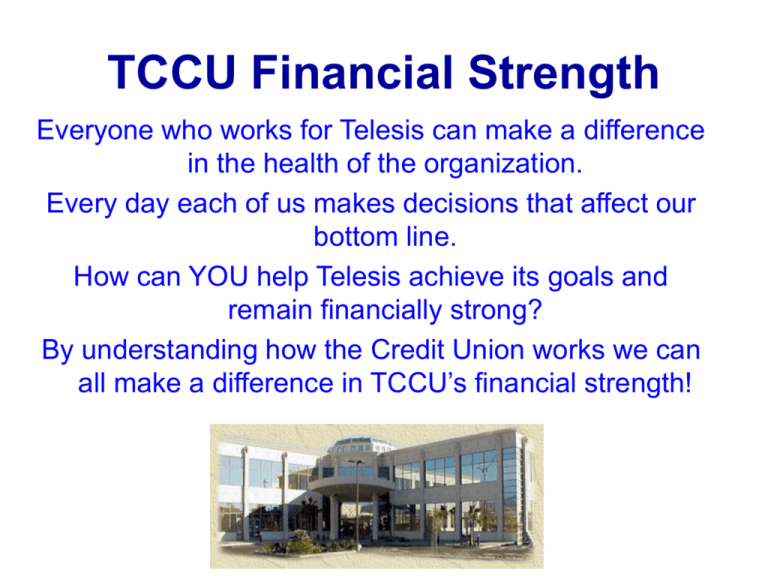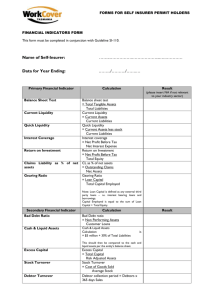
TCCU Financial Strength
Everyone who works for Telesis can make a difference
in the health of the organization.
Every day each of us makes decisions that affect our
bottom line.
How can YOU help Telesis achieve its goals and
remain financially strong?
By understanding how the Credit Union works we can
all make a difference in TCCU’s financial strength!
How TCCU Works
MEMBERS
SHARES
LOANS
Grow Capital
Earn Interest
Revenue
The money our members deposit with us is
then loaned out.
How TCCU Works
MEMBERS
With just over
30,000 members
we want to
continue to grow
our member base
SHARES
Lower cost deposits
such as checking and
savings accounts help
keep us on track to
meet our goals
We need our loan
balance to grow with
both secured loans, such
as Business loans, and
unsecured loans, such
as personal loans
Grow Capital
LOANS
Earn Interest
Revenue
The money we earn in interest on these loans is
used to pay the dividends on our share accounts.
DEFINITIONS
• Assets- Assets are everything you own that
has any monetary value, plus any money you
are owed. They include money in your
checking account, your stocks, bonds, and
mutual funds, 401(k), your equity in real
estate (value of your house minus the
amount you owe on it), the value of your life
insurance policy, and any personal property
that people would pay to own, such as a car,
television, DVD player, etc.
DEFINITIONS
• Assets (con’t.)- Similarly, a company's
assets include the value of its physical
building, its inventory, and less tangible
elements, such as its reputation. For Telesis
this means all the property that is available to
pay off any debts. For example, loans (we
own the houses and cars we lend money for
until they are paid off), cash investments
(money we invest with other institutions in
certificates, money market accounts, etc.)
and fixed assets (our corporate office,
furniture, computers, etc.)
DEFINITIONS
• Capital- Capital is any asset that is used to
generate income or make a long-term investment.
For example, on a personal level, the money you
use to buy shares in a mutual fund through your
401(k) is considered capital. So is the money you
use to make a down payment on a house.
Businesses use capital, which is often money from
loans or earnings, for reinvestment, expansion,
and acquisitions. For example, companies
sometimes acquire loans from other banks or
credit unions then use the money to invest in new
equipment or even loan the money out at a higher
rate to help them earn more money.
DEFINITIONS
• Equity- the amount something is worth
above and beyond what is owed on it.
Another way of saying this is: the difference
between the asset's current market value —
the amount it could be sold for — and any
debt or claim against it. For example, if you
own a home valued at $300,000 but still owe
$200,000 on your mortgage, your equity in
the home is $100,000.
DEFINITIONS
• Liability- a financial obligation of the
organization. In business, liabilities refer to the
claims against the assets of a corporation, and
may include accounts payable (bills received,
such as utilities, that we make payments on),
wages and salaries, dividends (the money paid
to members for deposits, similar to the interest
banks pay to their customers for deposits),
taxes, and debt obligations, such as bank loans
the CU has taken out and which we are required
to repay.
Personal liabilities can include the bills you pay
each month, such as car payments, utilities, etc.
DEFINITIONS
• Liquidity- the ability to meet the demand for
funds. If you can convert an investment easily
and quickly to cash, with little or no loss of value,
you have liquidity. For instance, Telesis has
certificates with other institutions which can be
cashed out quickly if necessary. The term is also
sometimes used to describe investments you
can buy or sell easily.
• Net worth- the total value of all assets, such as
house, car, furniture and investments, minus all
debts, such as mortgages and credit card bills.
DEFINITIONS
• Ratio- a relationship between two numbers
expressed as a percentage (ex. ROA is Net income
divided by Average assets which equals a
percentage).
So if Net Income = $8 mil. & Average Assets = $340
mil. then the ratio is 2.3%.
• Spread- the difference between interest earned and
dividends and interest paid. To put it another way, it is
the difference between the gross rate of a loan and the
net rate. So if we have a loan where the gross rate =
6% and the net rate = 5%, the spread is 1%, which is
collected from the borrower and retained as revenue
to the CU.
EQUATIONS
ASSETS
How do we figure out what our assets are?
An easy equation gives us this number:
Liabilities + Capital = Assets
So, if your Capital is $400 million and your
Liabilities are -$35 million, your total assets
are $365 million.
Liabilities are by definition a negative, so
you take that amount away from your
Capital amount to find your total Assets.
EQUATIONS
RETURN ON ASSETS
This measures how effectively TCCU uses
the assets at our disposal.
To calculate this you divide our Year to Date
net income by the Average Assets for the
year.
So, if our net income is $8 million and
our average assets are $340 million, our
Return on Assets would be about 2.4%
EQUATIONS
NET WORTH TO ASSETS
Net worth to assets: looks at our net worth as a
percentage of our assets. This demonstrates
the financial strength of TCCU.
The equation is Net Worth divided by Assets:
If our Net Worth is $35 million and our Assets
are $360 million then our Net Worth/Assets
would be 9.7%
EQUATIONS
LOAN TO SHARE RATIO
The Loan to Share ratio looks at the total
balances we carry in loans compared to the
total balances we have on deposit in shares.
To get the amount you divide the loan total by
the share total:
So if we have $290 million in loans divided by
$325 million in shares, your LTS ratio is 89%.
Said another way: 89% of our shares are
“loaned out”.
How it all makes sense
To understand this on a personal level, let’s
look at a sample household and figure out the
calculations for that. Our sample household
has the following values:
Assets: $130,000
Capital: $150,000
Liabilities: $20,000
Net Worth: $12,000
Net Income: $2,000
How it all makes sense
ASSETS
How do we know our household assets are
$130,000? Easy- we added our Capital to our
Liabilities (always a negative) to come up with
our total assets. Since our Capital is $150,000
and our Liabilities are $20,000 the solution is:
$150,000 - $20,000 = $130,000.
How it all makes sense
RETURN ON ASSETS
To figure out how well our household is using
its assets, we divide our Year to Date net
household income by the Average Assets for
the year:
$2,000 / $80,000 = 2.5% ROA
How it all makes sense
NET WORTH TO ASSETS
We need to know our household net worth to
assets to determine how financially sound our
household is. To calculate this we take our Net
Worth and divide that number by our Assets:
$12,000 / $130,000 = 9.2%
How it all makes sense
All of these numbers tell us how financially
sound our household is just as the CU
numbers tell us how financially strong
Telesis is. Once you understand where the
numbers come from, it is easy to determine
the financial stability of any organization, no
matter how big or small.
Conclusion
Now that you have learned about the different
financial terms and equations it’s time to test
your new knowledge.
Take the following quiz to see how much you
remember!
Quiz
1.
What is an “asset”?
a.
b.
c.
d.
2.
An ability or talent you have
Something with a monetary value
A type of bank check
A tax write off
Your “net worth” is:
a.
b.
c.
d.
How much your house is worth
Something you catch fish in
The total value of all your assets minus all debts
A product or service the credit union offers members
Quiz
3.
The term “liquidity” refers to:
a.
b.
c.
d.
4.
Stocks and bonds
An alcoholic drink
Keeping all your money in certificates
The ability to convert investments into cash easily
A “ratio” is:
a.
b.
c.
d.
A relationship between two numbers expressed as a
percentage
The difference between interest earned and dividends or
interest paid
Something you listen to music on
When you subtract one number from another
Quiz
5.
The equity in a home that is worth $250,00 and
has a balance owed of $175,000 is:
a.
b.
c.
d.
6.
$25,000
$50,000
$75,000
$100,000
The equation to calculate assets is:
a.
b.
c.
d.
Capital / Liabilities = Assets
Liabilities x Capital = Assets
Liabilities + Capital = Assets
None of the above
Quiz
7.
To calculate Return on Assets (ROA) you would:
a.
b.
c.
d.
8.
Multiply your YTD Net Income with your annual Average
Assets
Divide your YTD Net Income by your annual Average
Assets
Subtract your annual Average Assets from your YTD Net
Income
None of the above
Examples of “capital” are:
a.
b.
c.
d.
The down payment for your house
Money you use to buy stocks
Your monthly car payment
Both a & b
Quiz
9.
“Spread” is best described as:
a.
b.
c.
d.
The difference between interest earned and dividends or
interest paid
The amount something is worth above and beyond what
is owed on it
A type of condiment
The total of all your assets
10. You can help the Credit Union achieve its goals
by:
a.
b.
c.
d.
Helping to bring in deposits and loans
Understanding the key terms and equations
Helping to keep costs down and productivity high
All of the above
THE END
Thank you for participating in the Credit
Union Financials Training. Hopefully this
has given you the foundation you will need
to excel in your your career here at
Telesis. Good luck!
Credits
Created By:
Jean Seymour
Animation:
Jean Seymour
Edited by:
Jean Seymour
Assistance provided by:
Clip Art
Copyright 2004:
Telesis CCU
Jean Seymour
All Rights Reserved






